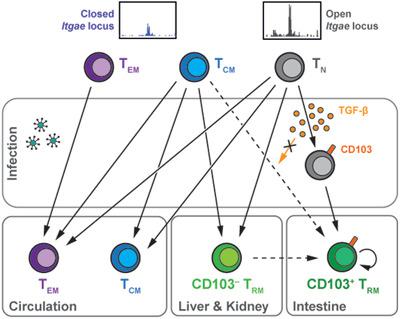当前位置:
X-MOL 学术
›
Eur. J. Immunol.
›
论文详情
Our official English website, www.x-mol.net, welcomes your feedback! (Note: you will need to create a separate account there.)
Circulating memory CD8+ T cells are limited in forming CD103+ tissue-resident memory T cells at mucosal sites after reinfection.
European Journal of Immunology ( IF 5.4 ) Pub Date : 2020-08-06 , DOI: 10.1002/eji.202048737 Felix M Behr 1, 2 , Ammarina Beumer-Chuwonpad 1 , Natasja A M Kragten 1 , Thomas H Wesselink 1 , Regina Stark 1, 2, 3 , Klaas P J M van Gisbergen 1, 2
European Journal of Immunology ( IF 5.4 ) Pub Date : 2020-08-06 , DOI: 10.1002/eji.202048737 Felix M Behr 1, 2 , Ammarina Beumer-Chuwonpad 1 , Natasja A M Kragten 1 , Thomas H Wesselink 1 , Regina Stark 1, 2, 3 , Klaas P J M van Gisbergen 1, 2
Affiliation

|
Tissue‐resident memory CD8+ T cells (TRM) localize to barrier tissues and mediate local protection against reinvading pathogens. Circulating central memory (TCM) and effector memory CD8+ T cells (TEM) also contribute to tissue recall responses, but their potential to form mucosal TRM remains unclear. Here, we employed adoptive transfer and lymphocytic choriomeningitis virus reinfection models to specifically assess secondary responses of TCM and TEM at mucosal sites. Donor TCM and TEM exhibited robust systemic recall responses, but only limited accumulation in the small intestine, consistent with reduced expression of tissue‐homing and ‐retention molecules. Murine and human circulating memory T cells also exhibited limited CD103 upregulation following TGF‐β stimulation. Upon pathogen clearance, TCM and TEM readily gave rise to secondary TEM. TCM also formed secondary central memory in lymphoid tissues and TRM in internal tissues, for example, the liver. Both TCM and TEM failed to substantially contribute to resident mucosal memory in the small intestine, while activated intestinal TRM, but not liver TRM, efficiently reformed CD103+ TRM. Our findings demonstrate that circulating TCM and TEM are limited in generating mucosal TRM upon reinfection. This may pose important implications on cell therapy and vaccination strategies employing memory CD8+ T cells for protection at mucosal sites.
中文翻译:

循环记忆CD8 + T细胞在再感染后在粘膜部位形成CD103 +组织驻留记忆T细胞受到限制。
组织驻留记忆CD8 + T细胞(T RM)定位于屏障组织,并介导针对入侵病原体的局部保护。循环中枢记忆(T CM)和效应记忆CD8 + T细胞(T EM)也有助于组织召回反应,但它们形成粘膜T RM的潜力仍不清楚。在这里,我们采用了过继转移和淋巴细胞性脉络膜脑膜炎病毒再感染模型来专门评估粘膜部位T CM和T EM的继发反应。供体T CM和T EM表现出强大的系统性召回反应,但在小肠中的积累有限,这与组织归巢和保留分子的表达降低相一致。在TGF-β刺激后,鼠和人循环记忆T细胞也表现出有限的CD103上调。一旦病原体清除,T CM和T EM容易引起了继发性T EM。T CM还在淋巴组织中形成了次级中央记忆,在内部组织(例如肝脏)中形成了T RM。T CM和T EM均未在激活小肠T RM的同时显着促进小肠的固有粘膜记忆,但对肝T却无作用。RM,有效地改造了CD103 + T RM。我们的研究结果表明,循环中的T CM和T EM在重新感染后在产生粘膜T RM方面受到限制。这可能对采用记忆性CD8 + T细胞在粘膜部位进行保护的细胞疗法和疫苗接种策略产生重要影响。
更新日期:2020-08-06
中文翻译:

循环记忆CD8 + T细胞在再感染后在粘膜部位形成CD103 +组织驻留记忆T细胞受到限制。
组织驻留记忆CD8 + T细胞(T RM)定位于屏障组织,并介导针对入侵病原体的局部保护。循环中枢记忆(T CM)和效应记忆CD8 + T细胞(T EM)也有助于组织召回反应,但它们形成粘膜T RM的潜力仍不清楚。在这里,我们采用了过继转移和淋巴细胞性脉络膜脑膜炎病毒再感染模型来专门评估粘膜部位T CM和T EM的继发反应。供体T CM和T EM表现出强大的系统性召回反应,但在小肠中的积累有限,这与组织归巢和保留分子的表达降低相一致。在TGF-β刺激后,鼠和人循环记忆T细胞也表现出有限的CD103上调。一旦病原体清除,T CM和T EM容易引起了继发性T EM。T CM还在淋巴组织中形成了次级中央记忆,在内部组织(例如肝脏)中形成了T RM。T CM和T EM均未在激活小肠T RM的同时显着促进小肠的固有粘膜记忆,但对肝T却无作用。RM,有效地改造了CD103 + T RM。我们的研究结果表明,循环中的T CM和T EM在重新感染后在产生粘膜T RM方面受到限制。这可能对采用记忆性CD8 + T细胞在粘膜部位进行保护的细胞疗法和疫苗接种策略产生重要影响。


























 京公网安备 11010802027423号
京公网安备 11010802027423号